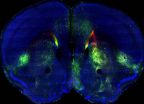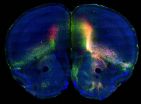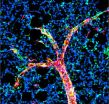(Press-News.org) Different brain regions must communicate with each other to control complex thoughts and behaviors, but relatively little is known about how these areas organize into broad neuronal networks. In a study published by Cell Press February 27th in the journal Cell, researchers developed a mouse whole-brain atlas that reveals hundreds of neuronal pathways in a brain structure called the cerebral cortex. The online, open access, interactive image database, called the Mouse Connectome Project, provides an invaluable resource for researchers interested in studying the anatomy and function of cortical networks throughout the brain.
"This study is the first comprehensive mapping of the most developed region of the mammalian brain: the cerebral cortex," says senior study author Hong-Wei Dong of the University of Southern California, Los Angeles. "Scientists can now use this anatomical map as a testable framework for exploring how each structure contributes to overall brain function."
The cerebral cortex—the outermost layered structure of neural tissue in the brain—plays a key role in regulating thoughts, emotions, and behaviors in mammals. Although scientists have mapped out neuronal connections on a small scale within specific parts of the mammalian brain, they have not achieved an accurate understanding of how cortical regions are organized into broad neuronal networks because they have used a patchwork of different techniques in different animal models. As a result, there has been a strong need for a thorough, rigorous, and consistent effort to map out neuronal connections spanning the entire mammalian cortex.
To address this need, Dong and his team generated a cortical connectivity atlas of the mouse brain using neuronal tracing techniques. They injected fluorescent molecules, which are visible under the microscope, into different areas across the entire mouse cortex. These molecules, which were transported along "cellular highways," labeled about 600 neuronal pathways. The researchers used a high-resolution microscope to scan the brain sections and create an image database of cortical connections.
When the researchers analyzed the connections, they found that the cerebral cortex is a highly organized network, consisting of eight subnetworks whose coordinated activity reflects an animal's feelings and perceptions. Moreover, this information is shared between subnetworks in a very specific way. "These findings challenge the widespread assumption that the cortex is a single network in which everything is densely connected with everything else," Dong says.
Moving forward, researchers can merge anatomical data from this important mammalian model system with the large amounts of existing molecular genetics data to identify fundamental types of nerve cells, an important objective of the NIH's BRAIN Initiative, which is part of a new Presidential focus aimed at revolutionizing our understanding of the human brain. "Determining the anatomical organization of the whole brain will be a fundamental and exciting step towards uncovering the structural underpinnings of brain function and its dysfunction in neurological disorders," Dong says.
INFORMATION:
Cell, Zingg et al.: "Neural Networks of the Mouse Neocortex."
Mouse brain atlas maps neural networks to reveal how brain regions interact
2014-02-27
ELSE PRESS RELEASES FROM THIS DATE:
Study uncovers why autism is more common in males
2014-02-27
Males are at greater risk for neurodevelopmental disorders, such as autism spectrum disorder (ASD), than females, but the underlying reasons have been unclear. A large cohort study published by Cell Press on February 27th in the American Journal of Human Genetics provides compelling evidence in support of the "female protective model," which proposes that females require more extreme genetic mutations than do males to push them over the diagnostic threshold for neurodevelopmental disorders.
"This is the first study that convincingly demonstrates a difference at the molecular ...
Male goat essence really turns the females on
2014-02-27
Anyone who has ever spent time around goats knows they have a certain smell. By carefully analyzing eau de male goat, researchers reporting in the Cell Press journal Current Biology on February 27 have now identified a novel, citrus-scented ingredient that speaks directly to the females. It acts on female goats' brains to turn their reproductive systems on.
The study is the first to uncover a pheromone that activates the central reproductive axis, according to the researchers. Although the work was done in goats, the researchers say there is reason to think the findings ...
Supplement added to a standard diet improves health and prolongs life in mice
2014-02-27
Activating a protein called sirtuin 1 extends lifespan, delays the onset of age-related metabolic diseases, and improves general health in mice. The findings, which appear online February 27 in the Cell Press journal Cell Reports, point to a potentially promising strategy for improving health and longevity.
Sirtuin 1, or SIRT1, is known to play an important role in maintaining metabolic balance in multiple tissues, and studies in various organisms have shown that activating the protein can lead to many health benefits. Also, drugs that increase SIRT1 activity have been ...
By zooming in on arteries, researcher gets to the root of pulmonary hypertension
2014-02-27
You might think building muscle is a good thing, but that's often not so in the case of blood vessels in adults. In fact, excess smooth muscle is a root problem in many vascular diseases, as it causes arteries to constrict and blood pressure to rise. Now, an in-depth analysis of arterioles in mice with pulmonary hypertension explains how those misplaced smooth muscle cells develop.
The findings reported in the Cell Press journal Cell Reports on February 27th are important because nearly half of patients with pulmonary hypertension die within three years of diagnosis, ...
Yale study provides a breath of hope for pulmonary hypertension patients
2014-02-27
Most of us draw roughly 25,000 breaths a day without any thought. But for patients with pulmonary hypertension, a life-threatening increase in blood pressure in the lungs, even the smallest task can leave them gasping for air. A new study by researchers at Yale School of Medicine offers insight into the function of cells linked to this incurable and often fatal illness.
Published Feb. 27 in Cell Reports, the study is the first to explore the cellular mechanisms behind the changes in the way cells are organized in pulmonary arteries in pulmonary hypertension, which leaves ...
Internal logic: 8 distinct subnetworks in mouse cerebral cortex
2014-02-27
The mammalian cerebral cortex, long thought to be a dense single interrelated tangle of neural networks, actually has a "logical" underlying organizational principle, reveals a study appearing Feb. 27 in the journal Cell.
Researchers have identified eight distinct neural subnetworks that together form the connectivity infrastructure of the mammalian cortex, the part of the brain involved in higher-order functions such as cognition, emotion and consciousness.
"This study is the first comprehensive mapping of the most developed region of the mammalian brain: the cerebral ...
New discovery paves the way for medicine for people with hearing disabilities
2014-02-27
Researchers at Karolinska Institutet in Sweden have identified a biological circadian clock in the hearing organ, the cochlea. This circadian clock controls how well hearing damage may heal and opens up a new way of treating people with hearing disabilities.
Important body functions, such as sleep, the immune system, and hormone levels are controlled by a biological circadian clock. A team of researchers at Karolinska Institutet have now discovered that there is also a biological clock in the ear, controlled by genes known to regulate circadian rhythms. One of these ...
Disease-causing bacterial invaders aided by failure of immune system switch
2014-02-27
Immune system defenses against dangerous bacteria in the gut can be breached by turning off a single molecular switch that governs production of the protective mucus lining our intestinal walls, according to a study led by researchers at Yale, the University of British Columbia, and the Weizmann Institute of Science.
"This gut microbiota has been linked to the inflammation that triggers obesity, diabetes, metabolic disease, and most of chronic health problems of the Western World," said Yale's Richard Flavell, Sterling Professor of Immunobiology, Howard Hughes Medical ...
Fruit fly's pruning protein could be key to treating brain injury
2014-02-27
DURHAM, NC -- A protein that controls the metamorphosis of the common fruit fly could someday play a role in reversing brain injuries, said Duke University researchers.
This protein directs both the early development and regrowth of the tiny branches that relay information from neuron to neuron. Known as dendrites, these thin structures that resemble tree branches are responsible for receiving electrical impulses that flash throughout the body.
Incorrect dendrite development or injury has been linked to neurodevelopmental or psychiatric diseases in humans, such as autism, ...
An ancient 'Great Leap Forward' for life in the open ocean
2014-02-27
It has long been believed that the appearance of complex multicellular life towards the end of the Precambrian (the geologic interval lasting up until 541 million years ago) was facilitated by an increase in oxygen, as revealed in the geological record. However, it has remained a mystery as to why oxygen increased at this particular time and what its relationship was to 'Snowball Earth' – the most extreme climatic changes the Earth has ever experienced – which were also taking place around then.
This new study shows that it could in fact be what was happening to nitrogen ...







